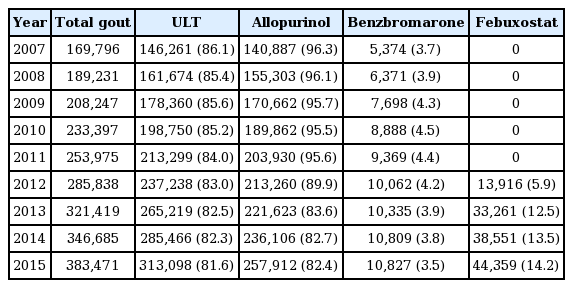Prescription pattern of urate-lowering therapy in Korean gout patients: data from the national health claims database
Article information
Use of urate-lowering therapy (ULT) is indicated in gout patients with recurrent acute gout attacks (≥ 2/year), tophi, chronic kidney disease stage ≥ 2, and/or past urolithiasis [1]. Appropriate use of ULT decreased not only the risk of gout flares, but also renal and cardiovascular events during the follow-up period [2]. Previous reports have investigated that ULT was prescribed in 23% (Taiwan), 38% (UK), and 42% (Sweden) of the gout population [3-5]. Xanthine oxidase inhibitors were the most common ULT prescribed in Sweden, whereas the uricosuric agents were the most common ULT prescribed in Taiwan. However, data on the prescription pattern of ULT are insufficient in Korea.
The aim of this study was to describe the prescription pattern of ULT in the South Korean gout population using the national health claims database 2007 to 2015. Patients who had at least one health claim for gout (diagnostic code: M10) as a primary or secondary diagnosis from January 1, 2007, to December 31, 2015, were included in the present study. The proportion of patients who were prescribed ULT (allopurinol, benzbromarone, or febuxostat) among the total gout patients was calculated for each year from 2007 to 2015. For the patients who were prescribed ULT, the last prescribed drug for ULT in each year was investigated. In addition, we discovered the proportion of patients who were prescribed ULT each year during a 5-year period, without considering a refill gap.
Number and percentage of patients prescribed ULT and subsets of allopurinol, benzbromarone, and febuxostat were shown in Table 1. The total number of gout patients increased from 169,796 in 2007 to 383,471 in 2015 (annual prevalence: 0.35% in 2007 to 0.76% in 2015). ULT was prescribed in more than 80% of the gout population. However, the proportion of ULT prescription decreased in contrast to the increasing trend in prevalence of gout. Allopurinol was the most commonly used drug for ULT. The rate of allopurinol prescription steadily decreased from 96% in 2007 to 82% in 2015. Benzbromarone was used in 3% to 4% of the ULT prescription. After febuxostat was approved in Korea, the use of febuxostat increased to 14% in 2015. Among gout patients who were prescribed ULT, only 33% to 38% of the patients were continuously prescribed ULT throughout a 5-year period. The proportion of patients who were continuously prescribed ULT was 33% in 2007 to 2012 period, which slightly increased to 38% in 2010 to 2015 period.

Gout patients who were prescribed ULT and proportion of allopurinol, benzbromarone, and febuxostat prescription
In contrast to studies conducted in other countries [3-5], our study revealed high rate of ULT prescription among the gout population. We assumed that the reason for this was the relatively low cost of this treatment for patients in Korea. Koreans are easily accessible to the health care service as all the population is covered by the National Health Insurance system and the Medical Aid program. Nevertheless, the continuation of ULT was still low. Patient-related factors and physician-related factors might contribute to the low rate of ULT continuation.
In conclusion, more than 80% of gout patients in Korea are prescribed ULT. Allopurinol is the most common ULT prescribed, but the use of febuxostat has increased in recent years. Among the patients who are prescribed ULT, only one-thirds are maintained with ULT during a 5-year period.
Notes
No potential conflict of interest relevant to this article was reported.
Acknowledgements
This work was supported by a grant from the Research Institute of Medical Science, Catholic University of Daegu (2016).